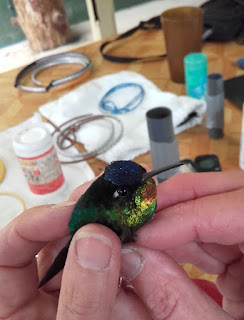We have returned today from the Highlands in Costa Rica, a 4wd journey via back roads to bypass the sometimes now non existent Pan-Am Highway. We managed 8 days of standard ringing since the storms, though isolated until today.
We are still finding new features in the avifauna of our Madre Selva site after many visits over the last 6 years. This fine adult male Spotted Wood-Quail, not a species we readily catch though common in the dense low cover of the Highland forest floor.
Spangle-cheeked Tanager, again a high elevation speciality infrequently caught but a core species of the roaming mixed species flocks. Often a couple of Golden-browed Chlorophonias are with the Spangle-cheeks, the Chlorophonias a species we have never been able to study.....yet
Sooty-capped Chlorospingus - often the leaders of the mixed flocks and a good vocalist to guide us.
Flame-throated Warblers are our second commonest resident warbler in the Highlands.
Antagonist of the smaller Hummingbirds, the Slaty Flowerpiercer.
This adult male - slightly leucistic and more importantly a bird we first ringed in 2014 and we have recaptured once a year on our Fall visit in each of the last 4 years.
The Highlands are full of Hummingbirds, maybe the commonest family of birds represented here ?
Here the delicate processsing of a stunning Fiery-throated Hummingbird.
The equally brilliant and iridescent Green Violetear, recently re-classified and another endemic to the Highlands of Costa Rica and Panama.
Chestnut-capped Brush-Finch, the most common species of Brush-Finch we capture. We caught a female with a brood-patch score 4, and a female Large-footed Finch too with bp4. Both species should have finished breeding months ago.
A couple of our most common migrants to finish this visit.
Swainson's Thrush, extremely common in the Lowlands and we find lesser numbers at the high altitude. We were delighted whilst birding early this morning before leaving to see 16 feeding in small groups and moving through. A migrant Olive-sided Flycatcher was a new species for us in the Highlands this morning too.
Behind Wilson's Warbler, Black-throated Warbler is the most abundant migrant warbler, this looking like a 1st winter male but what of the next bird.....
Clearly more Black-throated Green Warbler than Townsend's Warbler, but is it showing hybrid features, the black in the crown looks....?? We see and photo adult male Townsend's Warblers at our Highland sites each year.
A nice glossy capped male Wilson's Warbler...
At our Home banding station (as 6 years ago) a very powerful external security light came into use after the storms and the moths attracted added to the Highland experience !
This rather tatty Silkworm moth perhaps the largest of several large species attracted.
Finally a picture to help explain our isolation above the storm.....
A total of 78 landslides in the two directions - on the Pan American Highway not all quite as bad as this one.
Tomorrow we are off to a dry Tortuguero in the Caribbean......
Richard and Wendy














No comments:
Post a Comment
Please feel free to post comments but there may be a delay as they are all moderated to avoid spam